Trip ReportAcross North America by RailAugust 20-September 5, 2005
| |||||||||||
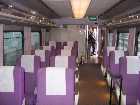
|
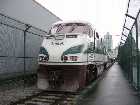
|
||
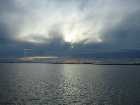
|
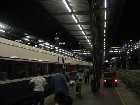
|
||
Origin: Pacific Central Station, Vancouver
Terminus: King Street Station, Seattle
Host Railroad: BNSF Railway
Time Performance At Detraining: Approximately 15-20 minutes late.
Consist:
- EMD F59PHI 466
- Talgo Power Car 7905 "Mt Adams"
- Talgo Business Class 7454
- Talgo Business Class 7554*
- Talgo Diner 7804
- Talgo Bistro 7305
- Talgo Coach 7504
- Talgo Coach 7424
- Talgo Coach 7423
- Talgo Coach 7422
- Talgo Coach 7421
- Talgo Coach 7420
- Talgo Baggage Car 7105 "Mt Adams"
- Non Powered Control Unit 90253
(*=My car)
Accommodations: Business Class.
A 403(b) Train: The Amtrak Cascades service is funded by the Washington State Department of Transportation and its Oregon counterpart (though this particular train route was only funded by Washington) under the terms of Section 403(b) of the Rail Passenger Service Act. The Amtrak Cascades service uses Spanish-made Talgo cars. These cars are shorter than normal 85-foot passenger cars. These cars are articulated-train sets that do not share a common four- or six-wheel axle. Instead, two cars share a two-wheel axle. An EMD F59PHI provides the motive power while a "Non Powered Cab Unit" (converted from a former F40PH locomotive) makes up the rear of the train to provide push-pull operation (That is, the engineer can ride in this unit to control the train in the opposite direction).
Border Crossing: Amtrak runs one round-trip of its Oregon and Washington State Cascades service from Seattle to Vancouver's Pacific Central Station. For passengers traveling southbound, you must first undergo a preliminary inspection made by unarmed officers of the United States Immigration and Customs Enforcement (ICE) agency. This involves some stupid questions from an officer about whether your baggage has any firearms or hazardous materials. Your luggage is then X-rayed by two Canadian Customs officers. Curiously, the ICE officers in Vancouver do not take your Customs Declaration Form. The train makes no stops from Vancouver until it reaches Blaine, Washington, where more ICE officers board. This time, they question each and Customs Declaration Forms are taken. Unlike their Canadian counterparts who boarded the Maple Leaf at Niagara Falls, Ontario, the American ICE officers were very brief. I was asked two questions and my officer moved on. The entire inspection took 20 minutes or less. Yet I remained curious why this was not just combined with the procedures back in Vancouver.
Scenic Highlight: Practically the entire route, which skirts the inlets and sounds of the Pacific Northwest from Vancouver to Seattle. My favorite part was going through White Creek, British Columbia as residents watched us from the park and rocky beach along the shoreline.
On-Board Food Service: In Vancouver, boarding commences an hour before departure. The train included a Bistro car and a Dining Car. Business Class passengers were given a voucher at check-in worth $3.00 in either car. Both the Bistro and Dining Car were open during the hour before departure, though neither could serve alcohol until the train began moving (a vagary of Canadian law). The Bistro featured usual Amtrak-type snack fare, but also had some special "Chef Martha" microwaved meals. I had the four-cheese macaroni, reasonably priced at 3.50. It was so good I went and had another. The Dining Car featured four entrees, including Prime Rib, but the prices were very high--over 11 dollars for each entree. The Bistro Car attendant was excellent: witty, fast, and professional.
On-Board Amenities: My business class car featured two video monitors. A movie (the remake of "The Honeymooners") was shown. You could use your own headphones or buy some for $4. The car also had illustrated route guides, much more elaborate than the picture-less ones you get on long-distance Amtrak routes.
Overall Grade: A+. I was super impressed with the quality of service that the Washington State Department of Transportation and Amtrak have provided for this train. Though the 6 pm departure time was a bit lame (it meant getting into Seattle late), the quality of the Talgo cars, the decent quality of the Bistro food, and the outstanding scenery of the route made this a trip to remember.
Amtrak #11, Coast Starlight 4-5 September 2005
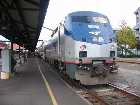
|
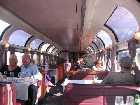
|
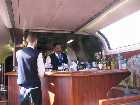
|
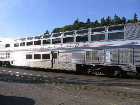
|
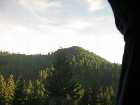
|
Origin: King Street Station, Seattle
Terminus: Los Angeles Union Station
Detrained At: San Jose Diridon Station
Host Railroads: BNSF (Seattle to Portland); Union Pacific (Portland to Los Angeles Union Station)
Time Performance At Detraining: Approximately 1 hour and 30 minutes late.
Consist:
- GE P42DC 119
- GE P32BWH 507
- Heritage Baggage Car 1164 Phase III
- Bombardier Superliner II Transition Dorm/Sleeper 39031 Phase IV
- Pullman-Standard Superliner I Sleeper 32032 Phase IVb
- Bombardier Superliner II Sleeper 32076 Phase IVb (former "Delaware")*
- Bombardier Superliner II Sleeper 32078 Phase IV "Florida"
- Budd Pacific Parlour Car 39972 Phase IV
- Pullman-Standard Superliner I Diner 38036 Phase IVb
- Bombardier Superliner II Lounge 32030 Phase IV
- Pullman-Standard Superliner I Coach 34078 Phase IV
- Bombardier Superliner II Family Coach 35410 Phase IV
- Pullman-Standard Superliner I Coach 34056 Phase IV
- Pullman-Standard Superliner I Coach-Baggage 31003 Phase IV
(*=My car)
Accommodations: Superliner II roomette #3. This roomette differed from a Superliner I mainly by the lack of the slim closet near the door. The AC plug was not recessed, which meant I did not need an extension cord to put in my travel surge protector. The lights still were not that bright inside the roomette.
America Up to the Challenge?: After four days aboard the best Via Rail Canada had to offer, could Amtrak respond? I had ridden the Coast Starlight once before (see my trip report on this site), and was very impressed. But after having just spent four days slightly chafing at the subtle and not-so-subtle Amtrak bashing from the dining car steward and several passengers, I was hoping Amtrak's premier train could step up to the plate. The Coast Starlight is not a luxury train, but it is supposedly the best America has to offer.
Sleeping Car Attendant: Donald. Without a doubt, the best attendant I had all trip. When Donald found out that I had an HO-scale brass model of our Pacific Parlour car, he and I were fast friends. Donald had worked as a teenager on Santa Fe's Hi-Level El Capitan.
Scenic Highlight: Puget Sound on the first afternoon then gives way to the forests and mountains of Oregon. By the next morning, the train skirts the Suisun and San Francisco Bays as it curves around into the East Bay. Again, I might upset Via Rail devotees, but the scenery on this route is just about as good as that featured on The Canadian.
On-Board Food Service: After two sub-par dining car experiences on the California Zephyr and Lake Shore Limited, I was happy to see that the Coast Starlight's Dining Car crew, led by Andrea, was on the ball. They were always friendly, always patient, always on top of their game. No, there was no Canadian Prime Rib, but I am not a foodie. If you can do up the Angus Beef Burger without over-microwaving it, I am a happy camper. Amtrak's Lounge car snack bar knocks the socks off the "take out window" on The Canadian.
Pacific Parlour: Without a doubt, what separates the Coast Starlight (besides its scenic route) from every other Amtrak train is its Pacific Parlour car. Amtrak's Pacific Parlour cars are only found on this route. They were refurbished from 1950s-era Santa Fe Hi-Level cars, the same cars that inspired the later Superliners. The Pacific Parlour features observation windows, a bar with free wine or soft drinks, continental breakfasts or hors d'oeurves, books, games, and a downstairs movie theater. All this is for sleeping car passengers only. The parlour attendant on this trip, though a young kid, played CDs of old 1940s and 1950s songs (like ones by Frank Sinatra) that really added to the retro-feel of the car.
Overall Grade: A+. Again, The Canadian's many devotees might disagree but the Coast Starlight measures up pretty well, provided you are not one to wax lyrical about how your bruschetta was presented. This train is a shorter journey but it is just as scenic and is far cheaper for sleeper accommodations. The train's crew-Amtrak's best-are just as good as their Canadian counterparts. They made me proud to be an American.
Epilogue
I set out on this journey to discover if passenger rail travel was still worth it in 2005.
To this I can answer a resounding "YES."
How do I know? On my last day aboard the Coast Starlight, I began plotting a new circumnavigation, this time using different trains or different segments.
As I had expected, some trains were better than others. I was sad to find the California Zephyr not in the same class as the Coast Starlight. A Superliner snob before this trip, I found that East Coast Viewliner trains are not so inferior after all.
In combination with my previous rides aboard Amtrak California, I found that states, under section 403(b), can provide excellent, modern, enjoyable corridor trains like the Cascades in Washington (Note to Secretary Mineta: These states are in the minority and cannot be depended upon to fund long distance trains).
I found that Chicago has a vibrant, if workman commuter train system. I loved the Bombardier cars and efficiency of GO Transit.
Most of all, I remember the people I met on board: people from so many places, many of them train travel fans, if not railfans or train buffs. There were Mike & Lillian, who I dined with aboard the California Zephyr in the deserts of Nevada...only to meet the couple again at King Street Station as we prepared to board the same Sleeper for our journey home to the San Francisco Bay Area. There was Donald-an excellent sleeping car attendant and a train fan. Finally, there were the two nice passengers who knew how shattered I was that I had to get off at San Jose. Along with Donald, they saw me off when I finally had to get off and admit my rail odyssey had ended.
